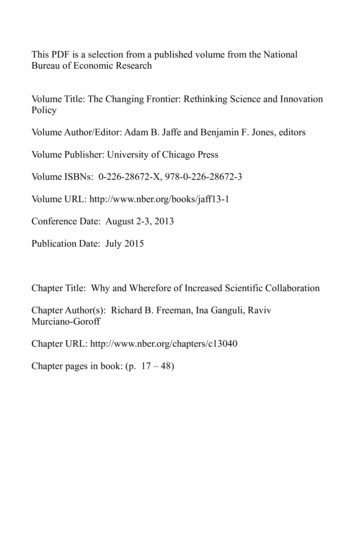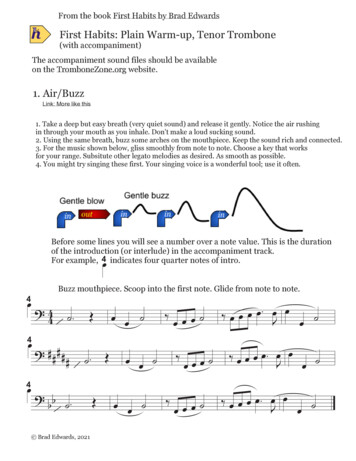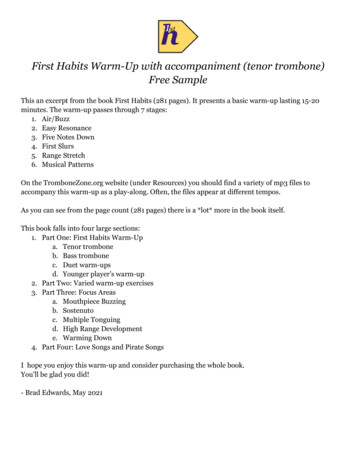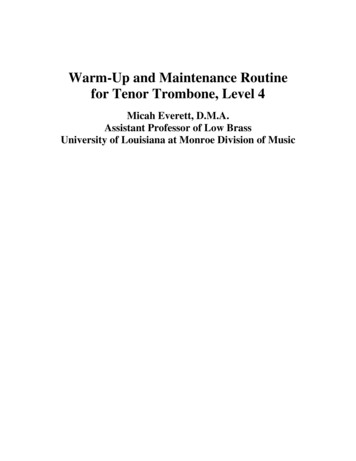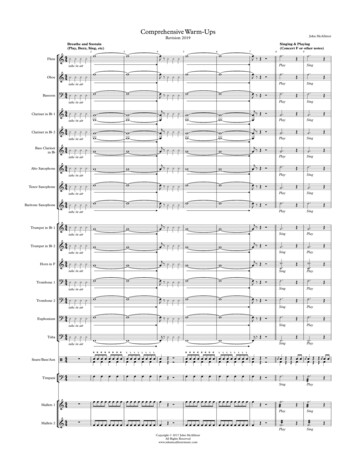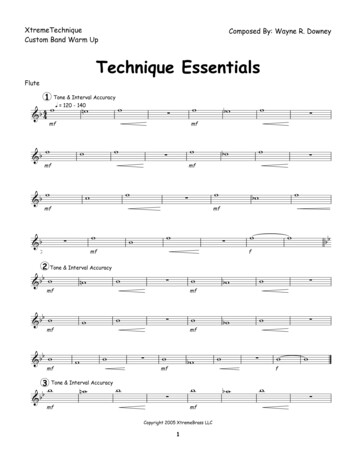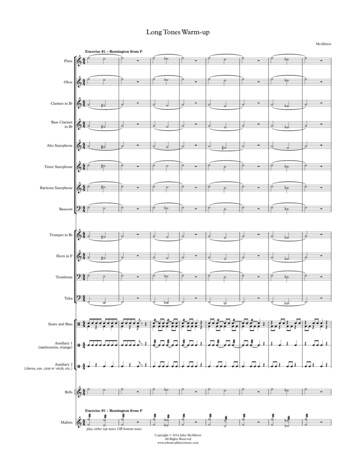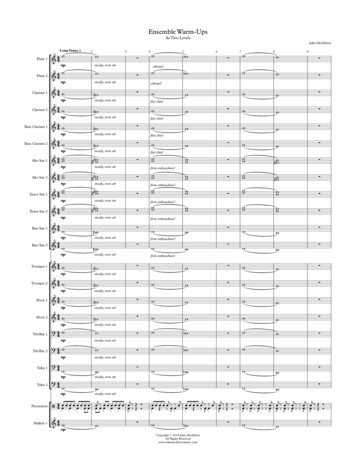
Transcription
rethinking yourwarm up
One leading educator thinks we should strike “warm up” from ourvocabularies. Another thinks we should do away with tuning up ourensembles at the beginning of rehearsals.Hear what these and other educators think about warm ups. Some oftheir actual warm up examples, offered for band, choir, orchestra, andjazz ensemble.Their approaches are certain to inspire you to try new warm upideas, engage your students, and ultimately make your rehearsalsmore productive.
contentsMake the Beginning of Rehearsal Engaging and Productive4Consider erasing “warm up” from your vocabulary. Instead, makesure that certain fundamental aspects of playing are practicedand improved before each rehearsal.[Band]In addition to developing both and ear training and part singing,warm ups can help improve student breathing, tone, range,and diction.[Choir]10A warm up isn’t only about getting fingers moving. It is a sacredtime set aside to help students physically and mentally preparefor a successful class.[Orchestra]Blues-Based Warm Ups for the Jazz Ensemble1326Technical drills will engage fingers and bodies, but minds willbegin to wander. Chorales will require students to listen, watch,and analyze right away.[Orchestra]Warm Ups Are My Secret Weapon28Apply Concert Band Warm Up Concepts to the Jazz Ensemble30Learn how to adapt concert band warm ups to the jazz ensemblerehearsal to ensure that your students efficiently develop theirtone, articulation, and reading skills.[Jazz band]16Master teacher Bob Phillips offers ways you and your studentscan save hours of practice and rehearsal time using carefullyplanned warm ups activities.[Orchestra Band]Reevaluating Warm-Up Routines 19At every opportunity we should seek ways to reinvigorate ourclasses, and reevaluate the class warm up routine, its purpose,and related strategies.[Orchestra]Using Chorales as Orchestra Warm UpsCarefully crafted warm-up activities set the stage for the entirerehearsal and help students learn repertoire more quickly.[Orchestra]The blues progression and blues scale can be the foundationsfor an excellent warm up for your jazz students – and a funintroduction to improvisation.[Jazz Band]The Importance of Warm up Time for Instrumental Teachers23Ground your warm up in a marriage of mindful practices and fun.Student enjoyment is key in building community in your choir.[Choir]My Elementary Choir Warm Up Philosophy 7Beginning Orchestra: Warm Up to SuccessA Mindful, Community-Building Choir Warm UpRethinking Your Warm Up: Never Tune AgainInstead of focusing on tuning once at the beginning of rehearsaland calling it good, Chris Bernotas suggests your studentsALWAYS focus on tuning.[Band]32
make the beginning of rehearsalengaging productiveI have taught band for more than twenty-five years. During that time I’vechanged many, many aspects of my teaching practice as I’ve learned anddiscovered new ideas. However, no element has evolved more than myapproach to “warm ups.”To begin, I have all but erased the words “warm up” from my teachingvocabulary, as they no longer accurately describe how I approach the firstfifteen to thirty minutes of my rehearsal. I am not really interested in warmingup the instrument. That will happen anyway. What I want is to get my studentsfocused and listening while making sure that certain fundamental aspects ofplaying are practiced and improved.The Calming Effects of RoutineThere is always an element of predictability to at least part of my fundamentalstime. There is something innately calming about routine. Parents of smallchildren often have a set bedtime routine that occurs each night. Perhaps thechild gets a drink of water, brushes his or her teeth, and then snuggles nextto mom or dad for a story, song, and goodnight kisses before turning on thenight light and being tucked in. The element of predictability helps the childfeel calm and relaxed.When we spend the first few minutes of our band class in a predictablemanner, this has a similar effect on our young musicians. Students are able toput the hustle and bustle of the passing period behind them and settle into asense of calm, which then sets the tone for the rehearsal ahead.BreathingOften the first thing that I ask students to do is a short breathing routine. Weaccompany the breathing with hand motions that mimic the direction of theair stream. In the photo on the following page, students are demonstrating thestarting position with their hands all the way out. When they breathe in, they’llmove their hands in towards their bodies.These motions allow me to visually monitor the students’ timing of the breath.This exercise is more about focusing the students’ minds and working ontiming than it is on developing breath capacity, although that can be asecondary benefit.Since my goal is to focus and calm the students, I tend to avoid askingstudents to fill their lungs to capacity in this exercise because of the tensionthat it creates in the body. When you try this in your own classroom, work toget students taking a full, relaxed and expansive breath on the inhale, whilemaking sure that the exhale is focused and directional.Breathing Routine for Focus and TimingThis chart, and the following bullet points, illustrate our breathing routine. Youcan see what the hand positions look like in my classroom in the photo on thenext page. Sip: Take a sip of air to release the note (your hand moves toward you)Out: Exhale the stale air (your hand moves away)In: Take a full, relaxed, two-count breath (your hand moves toward you)Out: Exhale a focused and directed stream of air for four beats (your handmoves away)
Fundamentals-Based ExercisesFollowing two or three minutes of breathing, I move into fundamentals-basedexercises. Students begin with a concert F whole note, followed by a wholerest in a repeating pattern.loop as short as possible. Once I am happy with the quality of thesound, my focus turns to the clarity of entrances and releases. Again,feedback is quick, continuous, and the students apply it immediately.We only stop the exercise if an extended explanation is needed, or if Iwant the students to respond to questions about what they hear.This exercise is beautifully simplistic. It can be performed by the youngestmusicians (on mouthpieces/small instruments) to the most proficient, whileallowing focus on all three parts of the note: beginning, middle, and end.Articulation ExercisesOnce clarity of entrances and releases are established, I move toexercises that focus on articulation consistency and accuracy.Exercises which keep students on a single pitch, such as Concert F,are preferable because they allow isolation of skill. If we try to tackle toomany things at once, our work will be less effective.Throughout the exercise, center feedback on helping the students to performwith a resonant, vibrant tone that matches that of their neighbors. As a result,students will hear lots of information concerning breath support, air speed,posture, embouchure, and vowel shape.The whole rest provides a perfect opportunity for me to give a few words offeedback which the students can then immediately apply, making the feedbackExercises such as the one above can be modified to work on a varietyof articulations and styles. Simply substitute in staccato, accent or anyother style to change the focus.
Exercises for Changing NotesOnly after clarity of tone and articulation are established, and I am certain thatstudents are focused, listening, and engaged in the fundamentals process,will I move into exercises where students change notes. These could includeRemington exercises, scale patterns, chordal patterns, or chorales. Use theseexercises to focus on changing notes with precision or improving intonation.Note that it is extremely important to stop periodically throughout thefundamental set to pose higher-level questions to your students. As yourstudents become more experienced listeners and musicians, your questionsshould become more in-depth.Example QuestionsBeginning Band: What did you hear? (This question gives student flexibility in how theyanswer and is safe because there really are no wrong answers!) What did you think of the tone quality of the clarinet section?Developing Band: Which section of the band do you hear sticking out of the ensemble texture? Describe the articulation you are hearing from the trumpet section. Whatwould you tell the trumpets to do to improve their articulation on this exercise?Advanced Band: What adjustments need to be made to tuning (or balance) in this chord inorder to achieve our best sound?As you structure your own “warm up,” try developing a fundamentals-basedroutine that focuses on mastery of breathing, embouchure, vowel shape,articulations, and releases. Because these skills drive nearly every otheraspect of playing, they must be practiced with a goal of excellence, rather thanmere proficiency.When fundamentals become automatic for your students, their minds willincrease their capacity to carry out more complex musical tasks, while stillperforming the fundamentals with precision and clarity. As a result, everythingyour students play will improve!Wendy Higdon is the director of bands and unified artsdepartment chair at Creekside Middle School in Carmel,IN and an active blogger on the subject of teaching band.Learn more on the On and Off the Podium website and theSmartMusic blog.
my elementary choir warm upphilosophyIf you’re like me, you have experienced some confusion about the purposeof choral warm ups. Many people seem to do warm ups because that’s whatthey’ve always done – before you sing, you warm up. Even after I understoodwhy I did my own personal warm ups in voice lessons, I still was falling backon some vague “warm ups are to choir rehearsals as stretches are to soccerpractice” explanation, which, as a non-athlete, didn’t really clarify things. However,through excellent instruction and mentors, and a plethora of experience, I finallyfeel like I have a handle on the purpose of warm ups.Why We Warm UpHere are my reasons for warm ups, in no particular order:Routine and TransitionWarm ups alert students that we are starting and they become part of the routineof rehearsal, something that students (and also the teacher) may find beneficial.Teaching and Reinforcing Vocal HealthWarm ups are the ideal place to teach basics like proper breathing, tall vowels,and how to access high notes. Since there is no performance goal, you canfocus on one skill per warm up. This focused preparation early in rehearsalprepares students to juggle more than one skill when they are working onconcert repertoire.Preparing Song-Specific SkillsThis is a subcategory of the point mentioned above. Do you have lots ofstaccato notes in one of your pieces? Long, connected phrases? Sudden orgradual dynamic changes? Choose a warm up that focuses on those aspects,or build your own. When you encounter that particular challenge later inrehearsal, you will find that with a quick reminder about the warm up, the skillhas already been mastered.Building MusicianshipWarm-up time is when I build ear training or partner song and round skills,depending on the level and goals of the group I’m working with. If you’reworking on ear training, incorporate intervals or patterns that occur in yourrepertoire. If you’re working on singing in parts, up the challenge level weeklyby adding more parts, changing standing positions, or reducing the numberof people on a part.Warm Ups for 5 Skill AreasWhen planning warm ups for my 3rd-grade choir, I cover the following skills inthe following order:1.2.3.4.5.BreathingToneRangeDictionEar training/part singingBelow I share an example and an explanation of a favorite warm up in each category.BreathingI incorporate focused breathing practice into every rehearsal, using anexpandable ball. I use this ball because it expands 360 degrees, providing agreat model for what the rib cage does when we take a full singers’ breath.During the first rehearsal, I tell kids that to sing well, we have to learn how tobreathe. I then elaborate that breathing for everyday life and breathing forsinging are different. This includes a short, age-appropriate explanation of thediaphragm and the rib cage, as well as a demonstration of a good singer’sbreath. I also demonstrate, in a slightly exaggerated way, a bad singer’s breath,
and have students identify what moves and doesn’t move during each type ofbreath. Students then practice their singers’ breaths.During subsequent lessons, students breathe with the ball, inhaling as itexpands and exhaling as it contracts. After a few lessons, I have studentscome to the front of the class and lead the breathing ball exercise, and I alsohave student monitors who identify a breathing star for each rehearsal.ToneThe short explanation of this exercise is: students sing “May we follow you” ona descending five-note scale.However, this warm up takes lots of preparation and kinesthetic work in orderto achieve its focus on pure vowel sounds and round tone. I cover one vowelsound each week, and each sound gets a picture, a hand movement(kinesthetic), and a descending five-note scale on that vowel.Week 1: Eh [ ] Picture: Elephant Kinesthetic: Flip hands so fingers face down and backs of fingers brushslowly up against cheeks.Week 2: Ee [i] Picture: Football goalposts Kinesthetic: Index fingers at the corners of the mouth (mimicking footballgoalposts). Make sure to encourage a tall sound here – kids can experimentwith a very lateral ee and then a tall one.
Week 3: ah [a] Picture: A face with a light bulb: “A-ha!” Kinesthetic: A palm perpendicular to face, hand moving either down or upand out in front of the mouth. Palm moving down is best if your kids havea hard time dropping their jaw, and palm moving up and out is best if youwant to bring the sound more forward.Week 4: ooh [u] Picture: A milkshake Kinesthetic: Fingers moving away from mouth like they’re pulling a threadout of it. For this vowel, I like to ask students what their favorite kind ofmilkshake is, then we pretend we’re drinking a milkshake through a straw,so they purse their lips. Then we use that mouth position to make a pure[u] sound and add the hand motion.Week 5: Oh [o] Picture: A face with a shocked open mouth Kinesthetic: The index finger drawing a circle in front of the mouth. Thiscomes after ooh because first we remember our milkshake flavors, thenwe drink them, and then we say, “Oh no, my milkshake’s gone!”Then in either week five or six, introduce the full “May We Follow You” withkinesthetics. Doing the kinesthetics in order while singing will be confusing fora few weeks – it helps if the teacher or a student who learned them quicklycan model.RangeThis warm up helps students stretch their range, and it is so absurd that kidscan’t help but enjoy themselves. Once they get up to E or F, I often have themshoot a layup on the top note, which helps them land on top of the note ratherthan approaching it from below.DictionTongue twisters get lips, jaws, and tongues moving to encourage excellentenunciation, and I’ve found the students of all ages love the challenge andsilliness that tongue twisters bring out. Both pitched and unpitched tonguetwisters will help students with diction practice.Ear Training / Part SingingMy favorite in this category is the song Fish and Chips. Many people are familiarwith this song in slightly varying iterations. It is a great introduction to singing inparts, as it has three standard sections that can all be sung simultaneously, plusa fourth verse that I learned while student teaching, which kids love for its “ick”factor. Introduce one section per week, and experiment with singing them inunison in order and splitting into different groups to sing them as partner songs.Pure FunI always end my elementary choir rehearsal with a song that is purely fun –something that they will keep singing after rehearsal and tell their friendsabout. However, if there is a day that my warm ups feel particularly laborious, orthe kids have lots of energy, or no energy, I may add one of these songs at theend of my warm up routine. These include any number of silly camp songsand are even more fun if they incorporate body movements ala the ChickenDance or the Hokey Pokey.As music educators, we stand on the shoulders of those who came before us.For many of the ideas that I’ve shared with you, and for their general knowledge,wisdom, and kindness, I would like to particularly thank Dr. Leila Heil, Kate Klotz,and Connie Dewlen.Lia Bendix teaches K-3 general music and sings in threechoirs in Cleveland, Ohio. Read her articles and bio on theSmartMusic blog.
.beginning orchestra: warm upto successI believe that every part of the lesson is just as important as the other. If onepart of the lesson is weaker than the others, it can affect the overall quality ofthe learning that day. Conversely, when each part flows seamlessly and is justas informative and engaging as the last, students and teachers walk out feelingfulfilled in their learning. Each step is just as important as the others, and it allbegins with the warm ups.Why Warm Up?Warm ups aren’t just about playing a scale to get your fingers moving. Theyare a sacred time set aside to help the musician physically and mentallyprepare for a successful class. Warm ups help students switch gears fromwhatever class or interaction they just completed to directing their focus onmusic. They establish a sense of routine and familiarity that builds on thestructured environment we all strive to create when we work with kids.There are several different kinds of warm ups I keep in my back pocket torotate through when starting off the lesson for the day, all intended to serve aspecific purpose.Physical PreparationI learned to respect the warm up in a particularly memorable college studioclass. Before giving us any tips, the professor asked us what we thought the
first step to warming up was – and then he called on me. I paused for amoment and said, “Scales and slow practice.” As great as that answer was,there was a crucial initial step that I missed: stretching.We proceeded to go through a series of stretches to warm up all the muscles,big and small, that are necessary for playing our instruments. I would haveloved to learn the importance of stretching as a beginning musician, so Iencourage this habit in my students now.Go through some basic stretches with them, and put them to music. Studentscan do finger taps on their knees or backs of their instruments, or tap eachfinger and the thumb together close to their ears so they can hear them makethat “pop” sound. Stretch out each arm, and slowly roll the neck or shoulders.Focus on posture. Go from sitting to standing without making a sound ormaking any unnecessary movements. Show your students how to sit upstraight by having them slump over their knees and sit up with each part oftheir vertebrae stacking on top of the other. Do a little bow hold warm up,tapping each finger on the bow, bending and straightening the thumb, focusingon the areas they still need work on. And finally, add the instruments and do a“quick check,” letting go of their instruments and making sure everything iseither staying on the shoulder (for violin and viola), between the knees (forcello), or on the inside of the leg (for bass).As far as music choices, find out what songs and artists your kids listen to andpick something relevant to them. My classes have enjoyed singing along toPerfect by Ed Sheeran and You Are the Best Thing by Ray LaMontagne whilethey warm up. In fact, one student proclaimed that it was her favorite part ofclass because of the music.Scales with Rhythms and ArticulationsOnce posture is looking solid and the muscles are warm, choose a scale or twoto work on for a few minutes. This can be done with a metronome, to a drone, inrounds (my students’ personal favorite), and with whatever rhyth
child gets a drink of water, brushes his or her teeth, and then snuggles next to mom or dad for a story, song, and goodnight kisses before turning on the night light and being tucked in. The element of predictability h


